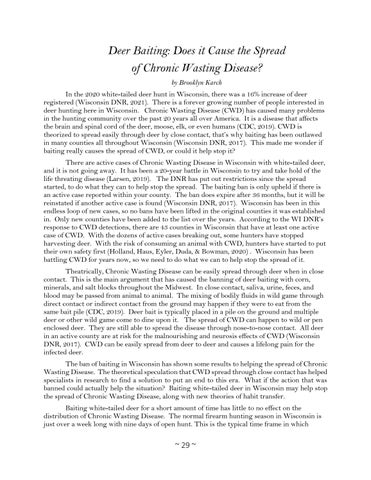Deer Baiting: Does it Cause the Spread of Chronic Wasting Disease? by Brooklyn Karch In the 2020 white-tailed deer hunt in Wisconsin, there was a 16% increase of deer registered (Wisconsin DNR, 2021). There is a forever growing number of people interested in deer hunting here in Wisconsin. Chronic Wasting Disease (CWD) has caused many problems in the hunting community over the past 20 years all over America. It is a disease that affects the brain and spinal cord of the deer, moose, elk, or even humans (CDC, 2019). CWD is theorized to spread easily through deer by close contact, that’s why baiting has been outlawed in many counties all throughout Wisconsin (Wisconsin DNR, 2017). This made me wonder if baiting really causes the spread of CWD, or could it help stop it? There are active cases of Chronic Wasting Disease in Wisconsin with white-tailed deer, and it is not going away. It has been a 20-year battle in Wisconsin to try and take hold of the life threating disease (Larsen, 2019). The DNR has put out restrictions since the spread started, to do what they can to help stop the spread. The baiting ban is only upheld if there is an active case reported within your county. The ban does expire after 36 months, but it will be reinstated if another active case is found (Wisconsin DNR, 2017). Wisconsin has been in this endless loop of new cases, so no bans have been lifted in the original counties it was established in. Only new counties have been added to the list over the years. According to the WI DNR’s response to CWD detections, there are 43 counties in Wisconsin that have at least one active case of CWD. With the dozens of active cases breaking out, some hunters have stopped harvesting deer. With the risk of consuming an animal with CWD, hunters have started to put their own safety first (Holland, Haus, Eyler, Duda, & Bowman, 2020) . Wisconsin has been battling CWD for years now, so we need to do what we can to help stop the spread of it. Theatrically, Chronic Wasting Disease can be easily spread through deer when in close contact. This is the main argument that has caused the banning of deer baiting with corn, minerals, and salt blocks throughout the Midwest. In close contact, saliva, urine, feces, and blood may be passed from animal to animal. The mixing of bodily fluids in wild game through direct contact or indirect contact from the ground may happen if they were to eat from the same bait pile (CDC, 2019). Deer bait is typically placed in a pile on the ground and multiple deer or other wild game come to dine upon it. The spread of CWD can happen to wild or pen enclosed deer. They are still able to spread the disease through nose-to-nose contact. All deer in an active county are at risk for the malnourishing and neurosis effects of CWD (Wisconsin DNR, 2017). CWD can be easily spread from deer to deer and causes a lifelong pain for the infected deer. The ban of baiting in Wisconsin has shown some results to helping the spread of Chronic Wasting Disease. The theoretical speculation that CWD spread through close contact has helped specialists in research to find a solution to put an end to this era. What if the action that was banned could actually help the situation? Baiting white-tailed deer in Wisconsin may help stop the spread of Chronic Wasting Disease, along with new theories of habit transfer. Baiting white-tailed deer for a short amount of time has little to no effect on the distribution of Chronic Wasting Disease. The normal firearm hunting season in Wisconsin is just over a week long with nine days of open hunt. This is the typical time frame in which
~ 29 ~






